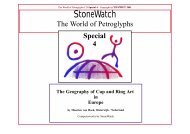petroglyphen im valle del encanto - StoneWatch
petroglyphen im valle del encanto - StoneWatch
petroglyphen im valle del encanto - StoneWatch
Erfolgreiche ePaper selbst erstellen
Machen Sie aus Ihren PDF Publikationen ein blätterbares Flipbook mit unserer einzigartigen Google optimierten e-Paper Software.
PETROGLYPHS<br />
AS ELEMENTS OF THE<br />
CULTURAL LANDSCAPE<br />
OF<br />
MUSTANG (NEPAL)<br />
Their contribution to research in cultural<br />
history and geography<br />
by Perdita Pohle<br />
Fig. 1: The location of petroglyph sites in Mustang (Nepal)<br />
In the last few decades, interest in rock art research and documentation<br />
has increased on a global scale. This has been<br />
due, in part, to recent technological developments and advances<br />
in the scientific methods of dating such as accelerator<br />
mass spectrometry (AMS) radiocarbon dating, thermoluminescence<br />
(TL) dating, and cation-ratio dating (see e.g. WAG-<br />
NER, 1995). The growing<br />
interest in rock<br />
art research has also<br />
been the result of the<br />
realization that petroglyphs<br />
and pictographs<br />
are not, as had long<br />
been presumed, s<strong>im</strong>ply<br />
graffiti which were created<br />
in early historic or<br />
prehistoric t<strong>im</strong>es by tribal<br />
peoples just to pass<br />
the t<strong>im</strong>e of day. Rather,<br />
they are cultural and<br />
historical documents<br />
which are a potential<br />
source of significant<br />
scientific information.<br />
Up until now, only a few rock art sites are known to exist in<br />
the H<strong>im</strong>alayas. They are located in northern India, in Ladakh<br />
and Zanskar (see FRANCFORT et al., 1990). Considering<br />
28<br />
the few locations of rock art known to exist in the H<strong>im</strong>alayas,<br />
the discovery of the rock engravings of Kak Nyingba in<br />
Mustang (Nepal) is an <strong>im</strong>portant one, especially in view of<br />
the fact that no rock art has been documented in Nepal up<br />
until now (Fig. 1). The petroglyphs were found by Phuntsok<br />
Naktsang, a Tibetan, and myself during fieldwork on the<br />
history and geography of settlements in the southern<br />
Mustang District in 1993. Two further sites of rock engravings<br />
(Samar, Tetang) were found during field trips in 1995<br />
to northern Mustang (Fig. 1). In addition to the documentation,<br />
analysis and interpretation of the petroglyphs, the objectives<br />
of the investigations were to integrate the rock art discoveries<br />
into the local history of the cultural landscape and<br />
the supra-regional cultural and geographical context.<br />
The petroglyphs of Kak Nyingba are located<br />
north of the main range of the H<strong>im</strong>alayas in the<br />
middle course of the Kali Gandaki River at a<br />
height of 2770 m (Fig. 1). The surrounding landscape<br />
is that of an arid high mountain area with<br />
oasis-like settlements and cultivation, an area<br />
which is populated by Tibetan people and characterized<br />
by Tibetan culture and tradition. The<br />
petroglyphs were carved into flat sandstone banks<br />
which are directly situated along the Kali Gandaki<br />
River. The deserted settlement of Kak Nyingba,<br />
after which the rock art site was named, lies in the<br />
vicinity. A further characteristic of the rock art<br />
locality is its situation along one of the most wellknown<br />
transit routes through the H<strong>im</strong>alayas, a<br />
caravan route which connects the Ganges Plain<br />
with the Tibetan Plateau and which, in former t<strong>im</strong>es, was<br />
used as a major route of international trade and commerce.<br />
The petroglyphs of Kak Nyingba were first hammered or<br />
chiselled into the rock with s<strong>im</strong>ple stone tools and then partly<br />
ground out and polished. In all, 1160 petroglyphs have<br />
been identified up until now. For the most part, they are dis-<br />
Fig. 2: Repertoire and typology of rock art motifs in Kak Nyingba<br />
(Nepal) (Draft: P. Pohle)
















